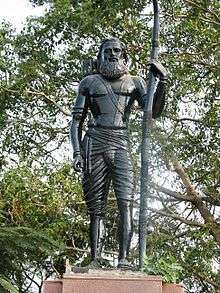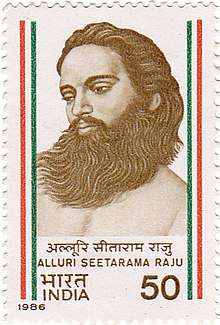Alluri Sitarama Raju
Alluri Sitarama Raju (1897 or 1898 – 7 May 1924) was an Indian revolutionary involved in the Indian independence movement. After the passing of the 1882 Madras Forest Act, its restrictions on the free movement of tribal people in the forest prevented them from engaging in their traditional podu agricultural system, which involved shifting cultivation. Alluri led the Rampa Rebellion of 1922, during which a band of tribal people and other sympathisers fought in the border areas of the East Godavari and Visakhapatnam regions of Madras Presidency, in present-day Andhra Pradesh, against the British Raj, which had passed the law. He was referred to as "Manyam Veerudu" (transl. 'Hero of the Jungle') by the local people.
Alluri Sitarama Raju | |
|---|---|
 | |
| Born | 1897 or 1898 |
| Died | 7 May 1924 (aged 25–27) |
| Cause of death | Executed by the British |
| Resting place | Krishnadevipeta, Andhra Pradesh, India |
| Known for | Rampa Rebellion of 1922 |
| Title | Manyam Veerudu |
Harnessing some aspects of the earlier non-cooperation movement and taking advantage of his own reputation among the tribal people, Alluri led raids on police stations in and around Chintapalle, Rampachodavaram, Dammanapalli, Krishna Devi Peta, Rajavommangi, Addateegala, Narsipatnam and Annavaram. With his followers, he stole guns and ammunition and killed several British police officers, including two near Dammanapalli. Alluri was eventually trapped by the British in the forests of Chintapalle, then tied to a tree and was executed by gunfire in Koyyuru village. His tomb is in Krishnadevipeta village.
Life
Details of Alluri's early life vary. An official report suggests that he was born in Bhimavaram taluk,[1] and several sources locate it as village of Mogallu, in West Godavari District.[2][3][4] More recent news stories name the village of Pandrangi, which lies in the Bheemunipatnam legislative assembly constituency, as his precise place of birth.[5]
His birthdate is also disputed. Several sources report it as 4 July 1897,[2][4][6] but others claim he was born in 1898[1] and, more specifically, his date of birth as 4 July 1898.[7]
Alluri was born in a Telugu-speaking family to Venkata Rama Raju and Suryanarayanamma.[1][8][9] Contemporary reports indicate that he had an undistinguished education but took a particular interest in astrology, herbalism, palmistry and horse-riding before becoming a sannyasi at the age of 18. They note that as he then wandered around the Godavari Agency, these interests and his charismatic nature gained him a reputation among the tribal people as being someone possessed of magical powers and holy, even messianic, status - a reputation that was bolstered both by myths he created about himself and by his acceptance of ones about him that were established by others, including ones concerning his reputed invincibility. Combined with his desire to overcome the colonial presence, expressed almost as if it were millenarian certainty, this was a powerful mixture.[3]
Rampa Rebellion of 1922
Origins
After the passing of the 1882 Madras Forest Act in an attempt to exploit the economic value of wooded areas, its restrictions on the free movement of tribal peoples in the forests prevented them from engaging in their traditional podu agricultural system, a subsistence economy which involved shifting cultivation.[10] The changes meant that they faced starvation and their main means of avoiding it was the demeaning, arduous, foreign and exploitative coolie system use by the government and its contractors for such things as road construction.[3]
Around the same time as the Act, the Raj authorities had also emasculated the traditional hereditary role of the muttadars, who had been de facto rulers in the hills as tax collectors for the plains-living rajas. These people were now reduced to the role of mere civil servants with no overarching powers, no ability to levy taxes at will and no right to inherit their position. Thus, the cultivators and the tax collectors, who once would have been in opposition to each other, were instead now broadly aligned in their disaffection with colonial power.[3]
Alluri harnessed the discontent of the tribal people to support his anti-colonial zeal, whilst also accommodating the grievances of those muttadars who were sympathetic to his aim rather than merely narrow-minded in their pursuit of a revived status for themselves. This meant that his followers were mostly from the tribal communities but did include some significant people from the muttadar class that at one time had exploited them, although many muttadars were ambivalent about fighting for what Alluri perceived to be the greater good.[3]
Alluri adopted aspects of the Gandhian non-cooperation movement, such as promoting temperance and the boycott of colonial courts in favour of local justice administered by panchayat courts, to attract support. Although the movement died out in early 1922, it had reached the plains area and he had been involved in propagation of some of its methods among the hill people as a means to raise their political consciousness and desire for change. It was these actions that caused him to be put under police surveillance from around February of that year, although the fact that he was using them as a camouflage to foment armed uprising seems not to have been recognised by either the movement's political leadership or the British.[3]
Actions
The armed rebellion began in August when Alluri led a mob of 500 people in the looting, on consecutive days, of police stations at Chintapalle, Krishna Devi Peta and Rajavommangi, from which he gained possession of guns and ammunition. He subsequently toured the area, getting more recruits and killing a member of a British police force that had been sent to find him. The British struggled in their pursuit, in part because of the unfamiliar terrain and also because the local people in this sparsely populated area were generally unwilling to help them and often outright keen to materially assist Alluri, including with shelter and intelligence. While based in the hills, contemporary official reports suggested that the core group of rebels dwindled to between 80 and 100 but this figure rose dramatically whenever they moved to take action against the British because of the involvement of people in the villages.[3]
Further deaths occurred on 23 September when Alluri ambushed a police party from a high position as they went through the Dammanapalli Ghat, killing two officers and cementing his reputation among the disaffected people. There were a further two successful attacks against the police forces during the month, after which the British realised that his style of guerilla warfare would have to be matched with a similar response, for which they drafted in members of the Special Malabar Police who were trained in such methods.[3]
Attempts to persuade local people to inform on or withdraw their support for Alluri, through both incentives and reprisals, did nothing but encourage them to further their actions.[3] Further raids were later made on police stations at Rampachodavaram, Addateegala, Narsipatnam and Annavaram.
Death

Alluri was eventually trapped by the British in the forests of Chintapalle. He was tied to a tree and shot dead in Koyyuru village.[11] His tomb is in Krishna Devi Peta village.[12]
In popular culture
- RRR is a fictional story directed by S. S. Rajamouli which is based on the lives of Komaram Bheem and Alluri Sita Ramaraju. The film deals with a figment of imagination added to construct the undocumented life of both the rebels who fought British in India, set in 1920.
- In 1986 the Indian Postal Department issued a commemorative stamp featuring Alluri in the series 'India's struggle for freedom'.[13]
- The Telugu-language movie Alluri Seetharama Raju, featuring actor Krishna, depicted Alluri's life.
- Andhra Pradesh is to celebrate his birthday, 4 July, annually as a state festival.[14]
- Alluri Sitarama Raju Cricket Stadium in Eluru is named after him.[15]
- On 9 October 2017, at the request of members of parliament, Thota Narasimham and V. Vijayasai Reddy, the Government of India decided to install a statue of Alluri at the precincts of the Parliament of India in recognition of his work as a freedom fighter, and for the welfare of the tribal people.[16]
References
- Guha, Ranajit (1982). Subaltern studies: writings on South Asian history and society. Oxford University Press. p. 134.
- Rao, P. Rajeswar (1991). The Great Indian Patriots. Mittal Publications. p. 12. ISBN 978-81-7099-288-2.
- Murali, Atlury (April 1984). "Alluri Sitarama Raju and the Manyam Rebellion of 1922-1924". Social Scientist. 12 (4): 3–33. doi:10.2307/3517081. JSTOR 3517081.
- Singh, M. K. (2009). Encyclopaedia Of Indian War Of Independence (1857-1947). Anmol Publications Pvt. Ltd. p. 127. ISBN 978-81-261-3745-9.
- "Pandrangi, Alluri's birthplace, selected under 'adarsh gram'". The Hindu. 14 January 2017. Retrieved 17 May 2018.
- Kesavanarayana, B. (1976). Political and Social Factors in Andhra, 1900-1956. Navodaya Publishers.
- Pfeffer, Georg; Behera, Deepak Kumar, eds. (1999). Contemporary society: tribal studies : Professor Satya Narayana Ratha felicitation volumes. 4. Concept Pub. Co. p. 151. ISBN 978-81-7022-738-0.
- Seshadri, K. (1993). Struggle for National Liberation: Role of the Telugu People from Early Days to 1947. Uppal Publishing House. ISBN 978-81-85565-34-7.
- Sharma, I. Mallikarjuna (1987). Role of Revolutionaries in the Freedom Struggle: A Critical History of the Indian Revolutionary Movements, 1918–1934. Marxist Study Forum. p. 140.
- Murali, Atlury (2017). "Tribal Armed Rebellion of 1922-1924 in the Madras Presidency: A Study of Causation as Colonial Legitimation". In Bates, Crispin (ed.). Savage Attack: Tribal Insurgency in India. Taylor & Francis. ISBN 978-1-35158-744-0.
- V. BalakrishnaG. "Freedom Movement in Andhra Pradesh". Government of India Press Information Bureau. Archived from the original on 13 January 2002. Retrieved 28 March 2011.
- "Birth anniversary of Alluri celebrated". The Hindu. 5 July 2012. Retrieved 2 February 2015.
- A. S. RAJU. "Indian Post" (26 December 2016). Retrieved on 11 December 2018.
- "AP to celebrate 117th birthday of Sri Alluri Sitarama Raju". 2 July 2014. Archived from the original on 14 July 2014.
- Nagaraja, G (23 May 2014). "ASR Stadium to get facelift". The Hindu. Eluru. Retrieved 27 September 2015.
- "Nod for installing Alluri's statue in Parliament". The Hindu. 9 October 2017.
Further reading
- Mukherjee, Mridula (2004). Peasants in India's Non-Violent Revolution: Practice and Theory. SAGE. ISBN 978-0-76199-686-6.
| Wikimedia Commons has media related to Alluri Sita Rama Raju. |